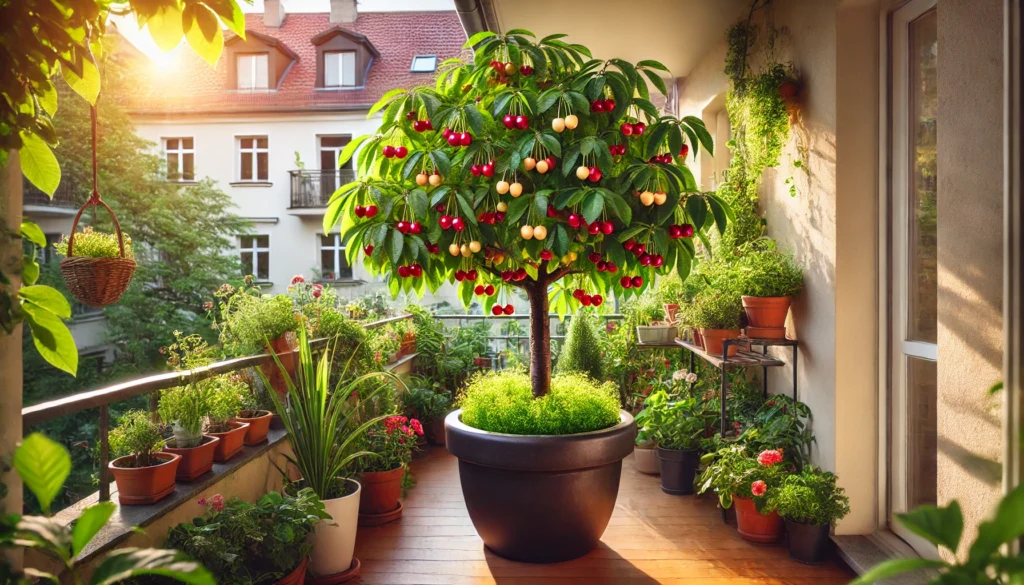
How to Care for Cherry Trees in Containers: Tips for Successful Growth
Growing cherry trees in containers is a rewarding way to enjoy fresh fruit, even if you have limited space. But how do you ensure these beautiful trees thrive in a confined space? How to care for cherry trees in containers: Tips for success is the key to fostering healthy, productive plants. Whether you’re a seasoned gardener or a beginner, proper care, from selecting the right container to managing watering and fertilization, will make all the difference. In this guide, we’ll walk you through everything you need to know to give your cherry tree the best chance for success, all while enjoying the beauty and benefits of container gardening.
Table of Contents
ToggleWhy Grow Cherry Trees in Containers? 

Growing cherry trees in containers offers many benefits that can transform your garden or balcony into a fruitful oasis! Here’s why you should consider it:
- Space-Saving Solution
If you’re limited on space, container gardening is your best friend. Cherry trees can thrive in pots, allowing you to grow them on balconies, patios, or even small yards. Perfect for urban environments! - Mobility & Flexibility
Container-grown cherry trees are portable. You can move them around to find the ideal spot with the right amount of sunlight or even protect them from extreme weather by shifting them indoors. - Better Control Over Growing Conditions
Growing cherries in containers lets you control the soil, water, and nutrients more effectively, ensuring your tree gets everything it needs. Plus, you can prevent soil-borne diseases, which can be more common in ground planting. - Perfect for Small Varieties
Dwarf cherry tree varieties are perfect for containers. These trees stay compact, which makes them ideal for small spaces, and you can still enjoy fresh, homegrown cherries right at your fingertips. - Ornamental Appeal
Cherry trees aren’t just about the fruit! Their beautiful blossoms bring a touch of elegance to any space. Container planting enhances their aesthetic, giving you a stunning addition to your outdoor decor.
By growing cherry trees in containers, you can enjoy these amazing benefits while making the most of limited space!
Choosing the Right Cherry Tree Variety 

When selecting a cherry tree for your garden, picking the right variety is crucial for both aesthetic and practical reasons. 
1. Consider Your Climate 

Different cherry varieties thrive in different climates. Some, like the Montmorency, are perfect for colder regions, while Bing cherries grow well in warmer areas. Be sure to pick a variety that matches your local climate to ensure healthy growth.
2. Sweet vs. Tart Cherries 

- Sweet cherries like Bing or Rainier are delicious for fresh eating and have a deep, rich flavor.
- Tart cherries such as Montmorency are best for baking and preserves due to their tangy flavor.
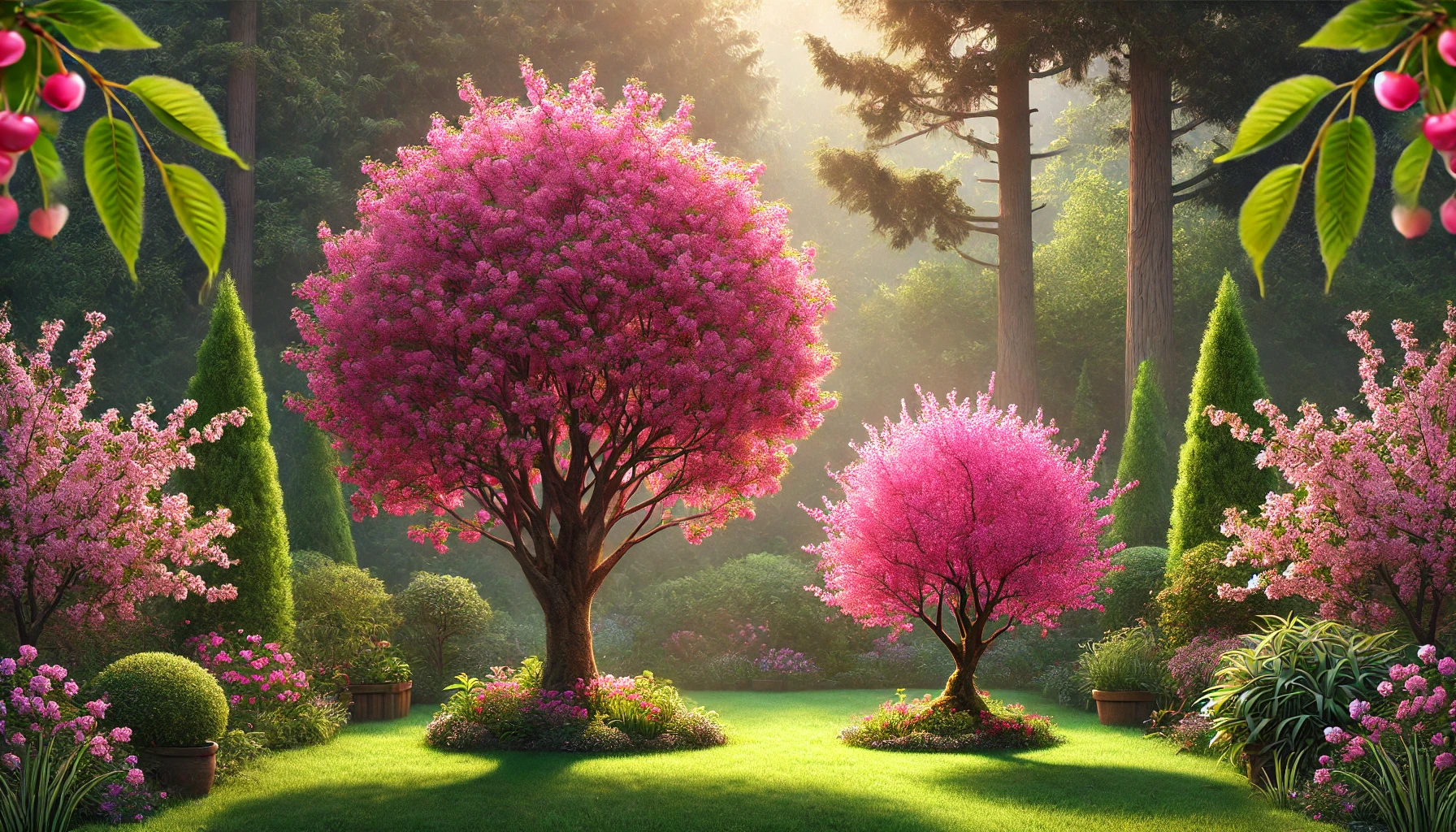
3. Space Considerations 
Cherry trees can grow quite large, so consider the space in your garden. Dwarf varieties, like Stella or Compact Stella, are perfect for smaller spaces and container gardening, while traditional trees require more room to spread out.
4. Pollination Needs 

Some cherry trees are self-pollinating (e.g., Stella), while others, like Bing, require another cherry tree nearby for cross-pollination. Make sure you plant at least two compatible varieties if your chosen tree isn’t self-pollinating.
5. Harvest Time 

The timing of your harvest can vary. Early-season varieties, such as Early Richmond, ripen earlier, while late-season cherries like Lapins are ready to harvest later in the summer.
By taking these factors into account, you can select the ideal cherry tree variety that will thrive in your garden and provide you with delicious fruit year after year!
Selecting the Perfect Container 

When choosing a container for your plants, size, material, and drainage are key factors to consider. Here’s how to get it right:
- Size Matters
- Pick a pot that’s 1-2 inches larger than your plant’s current root ball to allow room for growth.
- Too small? Your plant may become root-bound. Too big? The soil could stay too wet, which harms the roots.
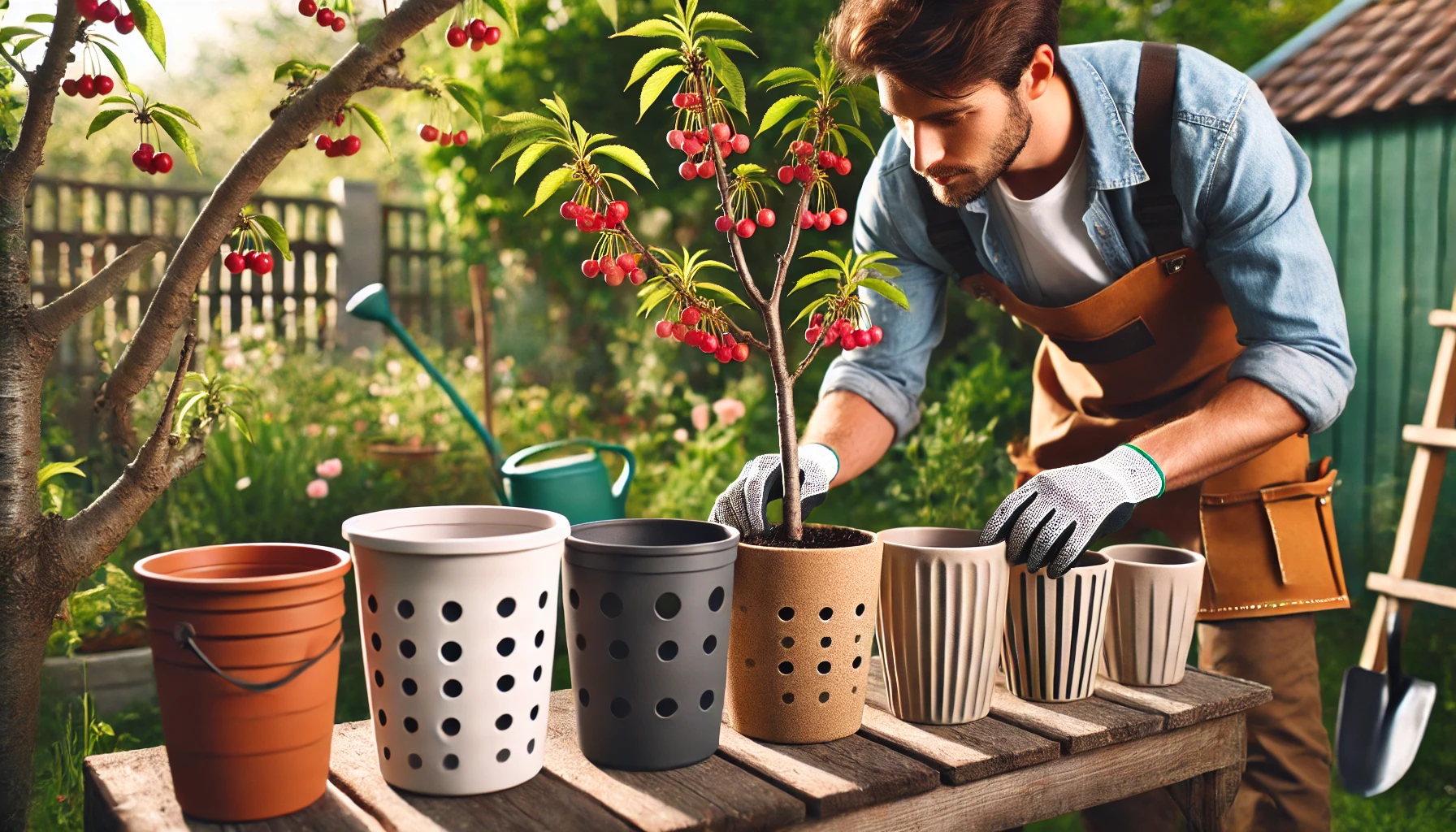
- Material Choice
- Plastic pots are lightweight and retain moisture well, but they can heat up in the sun.
- Clay or terracotta pots are porous and breathable, which is great for plants that like to dry out between waterings.
- Ceramic pots are stylish and sturdy but often come with a higher price tag.
- Drainage is Crucial
- Always choose a container with drainage holes to prevent water from pooling and causing root rot.
- If your pot doesn’t have drainage, you can easily drill some holes to improve airflow to the roots.
By keeping these points in mind, you’ll ensure your plant has the right home to thrive!
Soil and Fertilization Tips for Container Cherry Trees 

To grow healthy container cherry trees, the right soil and fertilization are key! Here’s how to ensure your tree thrives in its pot.
1. Choosing the Right Soil 
- Well-draining soil is essential for cherry trees. Opt for a potting mix designed for fruit trees or make your own mix using 1 part perlite, 1 part pine bark, and 1 part compost. This ensures the soil doesn’t retain excess moisture, preventing root rot.
- Cherry trees prefer slightly acidic soil with a pH range of 6.0–7.0. Regularly test the pH to keep it balanced.
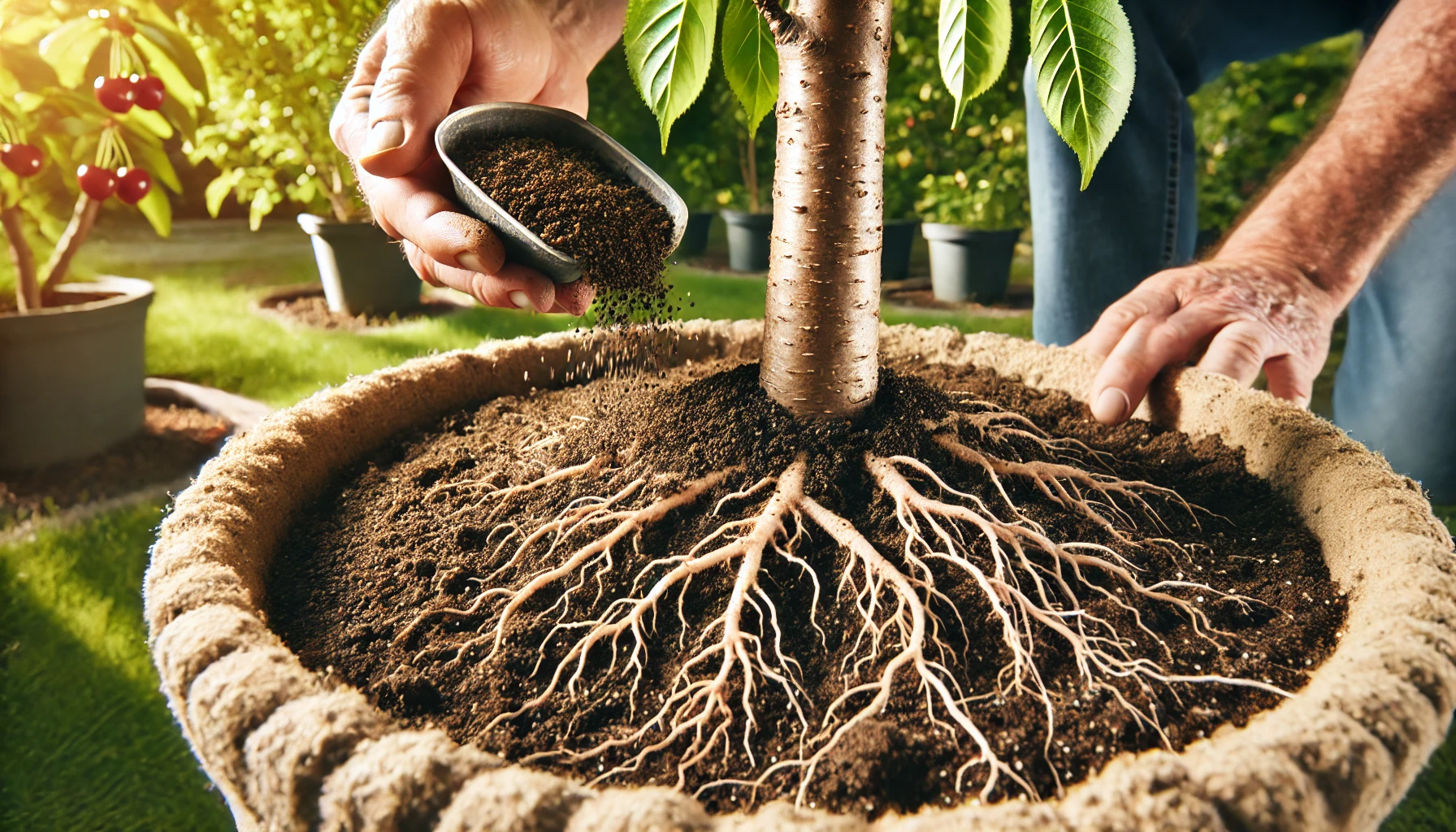
2. Fertilizing Cherry Trees 
- Use a balanced fertilizer (10-10-10 or 20-20-20) in the spring when your tree starts to show signs of new growth.
- Slow-release fertilizers are best for container trees. Apply according to package instructions, generally every 4-6 weeks during the growing season.
- For organic options, try fish emulsion or compost tea, which provide slow nourishment without overfeeding.
3. When to Fertilize 
- Spring to early summer is the prime time for fertilization. Stop fertilizing in late summer to allow your tree to prepare for winter dormancy.
- Over-fertilizing can lead to excessive foliage growth at the expense of fruiting.
4. Repotting and Soil Refreshing 
- Every couple of years, refresh the soil by gently removing the top layer and adding fresh mix. This keeps the tree’s roots healthy and prevents nutrient depletion.
- Repot your cherry tree every 2–3 years, choosing a container 1-2 inches larger than the current one. Be sure to use fresh potting mix to encourage optimal root growth.
With these soil and fertilization tips, your container cherry tree will be set for healthy growth and abundant fruit!
Watering Your Cherry Tree 

Proper watering is crucial for the health and growth of your cherry tree 
- Water Deeply, Not Frequently
Cherry trees prefer deep watering that reaches their roots, so aim for less frequent but more thorough watering. This encourages strong root growth. Make sure the soil is moist about 3-4 inches down. - Keep the Soil Consistent
Cherry trees thrive in well-drained soil. Avoid waterlogged soil, as it can lead to root rot. If the soil is too dry, water thoroughly, but if it’s too wet, reduce watering. - Water During Dry Spells
During hot, dry months, your tree might need more water. Water it every 5-7 days, especially in its first few years. In cooler seasons, you can water less frequently.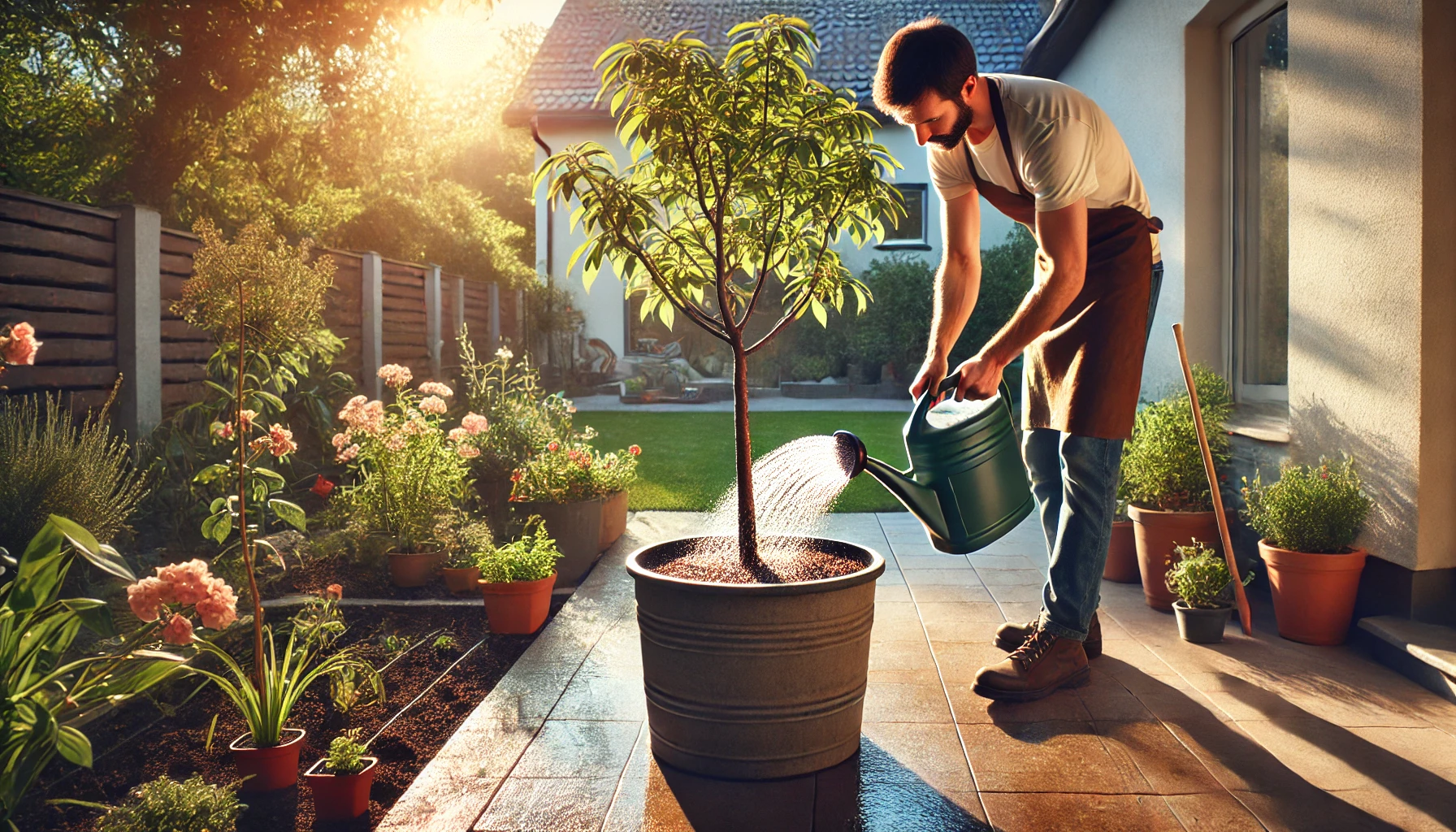
- Mulch Around the Base
Mulching helps retain moisture and keeps the roots cool. Use a layer of mulch (3-4 inches) around the tree’s base, but avoid piling it against the trunk to prevent disease. - Watch for Signs of Overwatering
Yellowing leaves and wilting can indicate that you’re overwatering. Ensure good drainage to prevent water from stagnating around the roots.
Water your cherry tree wisely, and you’ll enjoy beautiful blooms and a healthy harvest!
Providing Adequate Sunlight 

To ensure your plants thrive, proper sunlight is essential! 
- Know the Light Needs
: Different plants need different amounts of sunlight. Some love full sun (6+ hours a day)
, while others prefer partial shade
. Check your plant’s specific needs before choosing a spot.
- Choose the Right Location
: For outdoor plants, plant them in areas that get the right amount of sunlight based on their preferences. For indoor plants, place them near windows with the most sunlight. East-facing windows are perfect for moderate light
.
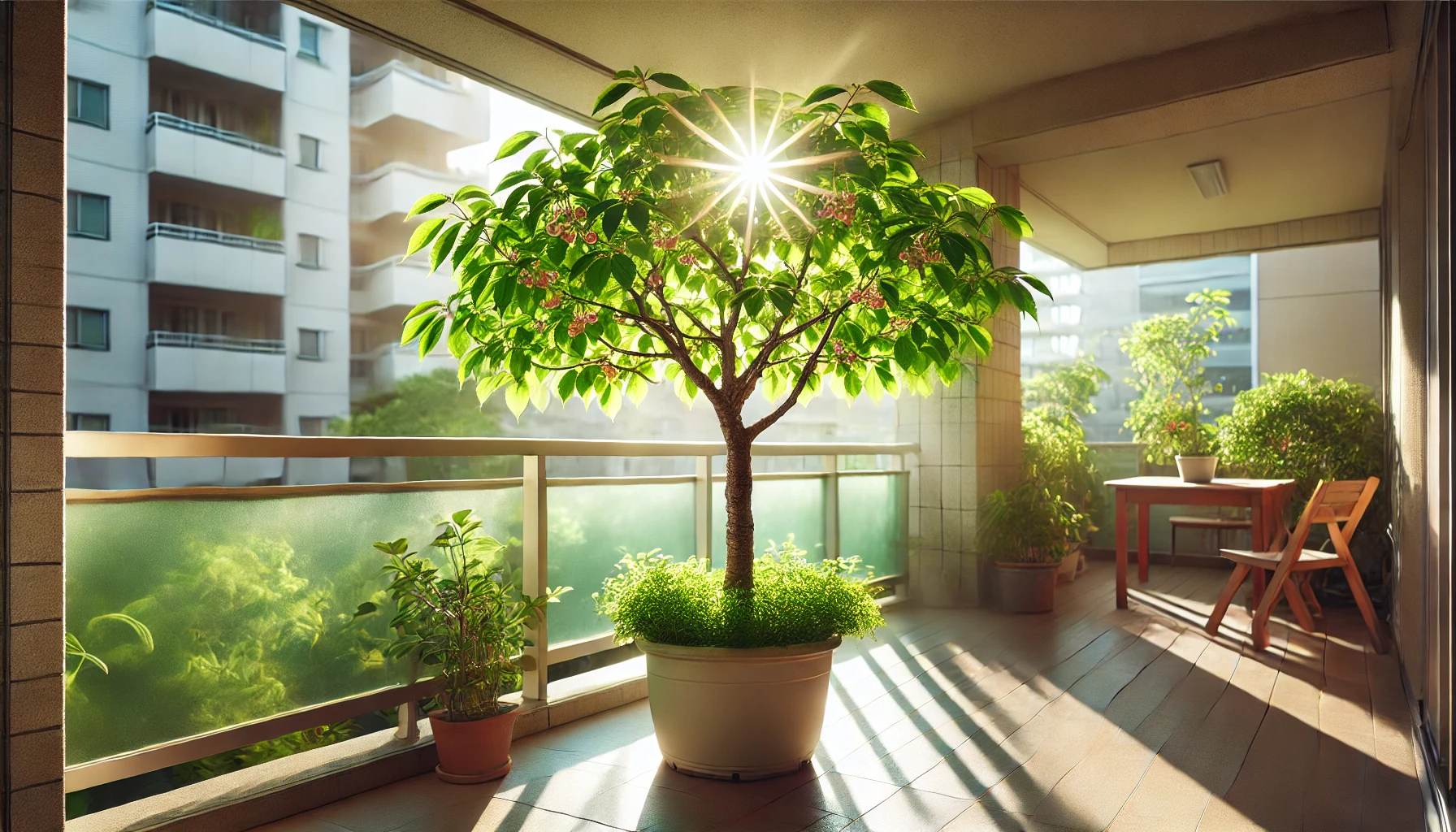
- Rotate Your Plants
: If you’re growing plants indoors, make sure to rotate them every few weeks to ensure all sides get enough sunlight.
- Use Sheer Curtains
: If your plants are getting too much direct sunlight, use sheer curtains to filter the light and protect them from burning.
- Watch for Signs of Stress
: If your plants are getting too much sunlight, you might notice scorched or brown leaves. If they’re not getting enough, they may become leggy and stretched out.
With the right balance of sunlight, your plants will grow strong and healthy!
Pruning and Shaping Your Cherry Tree 

Pruning your cherry tree is essential for healthy growth, better fruit production, and maintaining its beautiful shape. Here’s how to do it right:
- Best Time to Prune
Prune your cherry tree in late winter or early spring before the buds start to swell. This ensures the tree is dormant and prevents excessive sap loss. - Tools You’ll Need
Use sharp pruning shears for small branches and a pruning saw for larger ones. A clean cut helps reduce the risk of disease. - How to Prune
- Remove dead or diseased branches to keep the tree healthy.
- Thin out crowded branches to improve airflow and sunlight penetration.
- Shape the tree by trimming back long, leggy growth and maintaining a balanced structure.
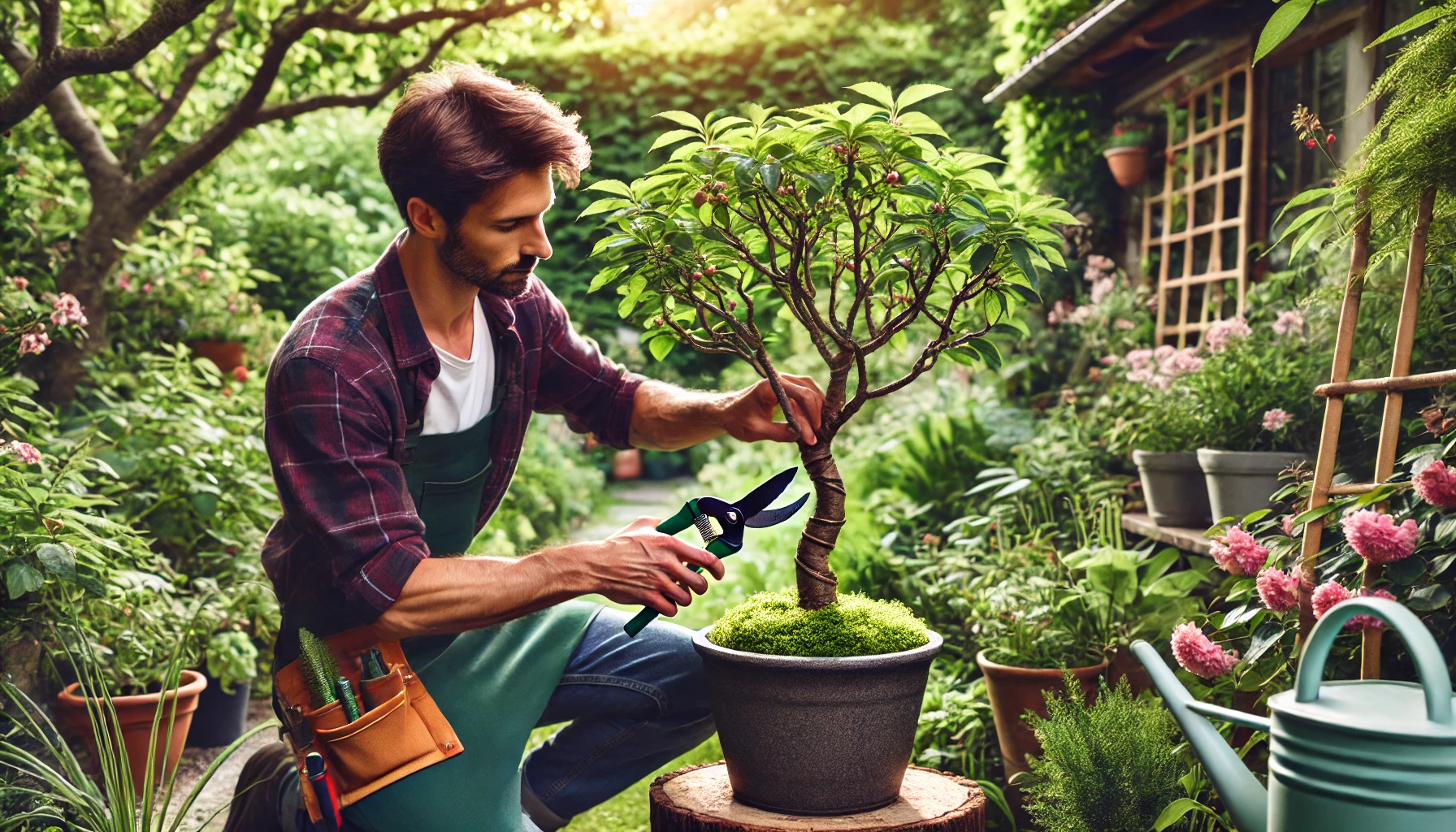
- Cutting Techniques
Always cut at an angle, just above a bud or lateral branch. This encourages new growth and prevents water from collecting in the cut. - Maintain the Central Leader
Keep the main trunk (central leader) clear of competing branches. This helps the tree grow tall and straight. - Don’t Overdo It
Avoid heavy pruning. Cherry trees don’t require much cutting, and removing too much can reduce fruiting and weaken the tree.
By following these simple steps, your cherry tree will thrive and provide you with a bountiful harvest season after season!
Pollination and Fruit Production 

Pollination is a crucial step in ensuring your plant produces vibrant fruits. 
- Attract Pollinators
: Invite bees, butterflies, and other insects by planting nearby flowers that attract them. This will help ensure your plant gets the attention it needs for successful pollination.
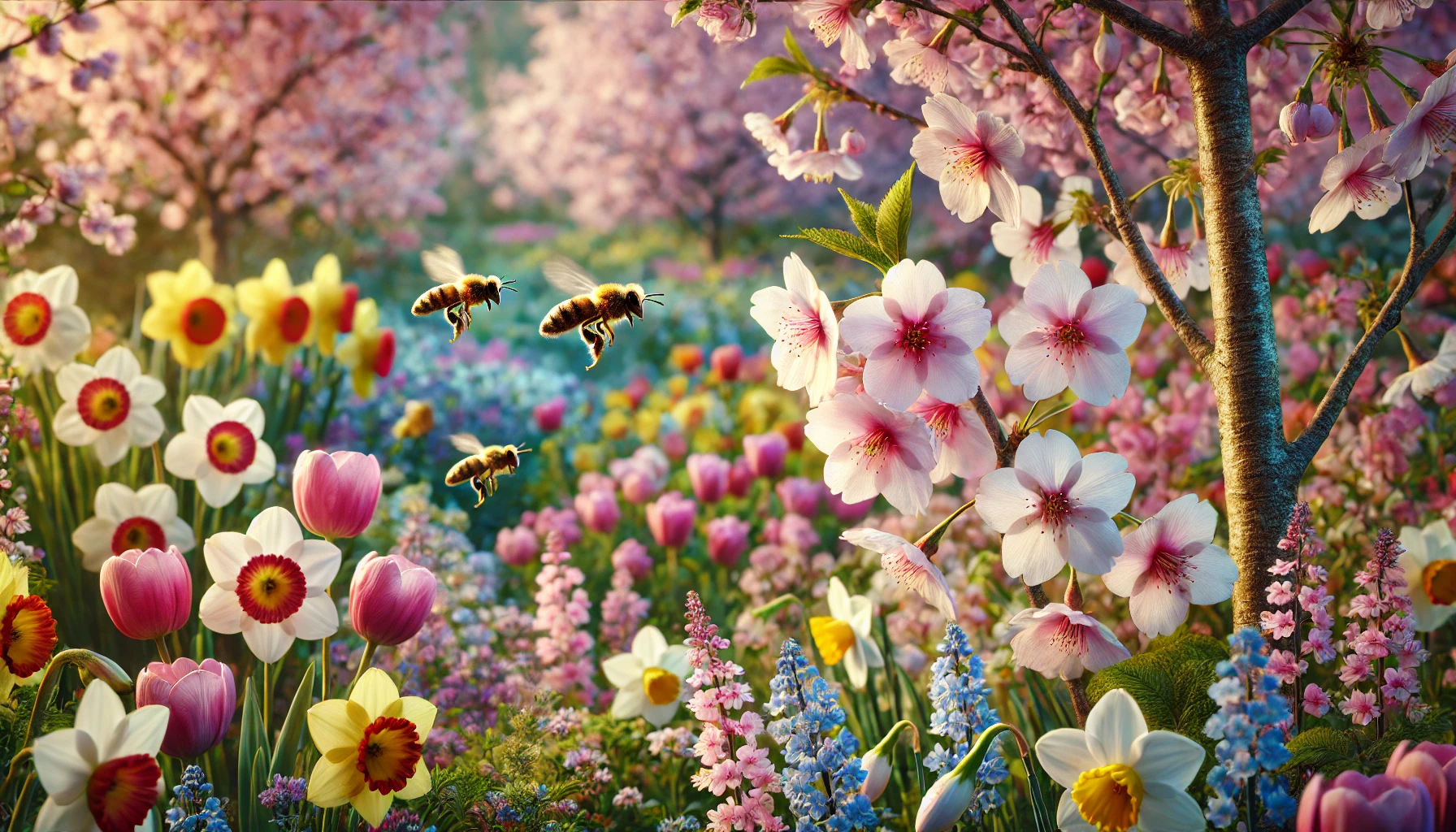
- Hand Pollination
: If your plant doesn’t attract enough pollinators, consider hand-pollinating. Use a small brush or cotton swab to transfer pollen from one flower to another.
- Timing is Everything
: Most plants have specific times when their flowers are most receptive to pollination. Morning hours are often ideal for catching pollinators at their peak activity.
- Provide Ideal Growing Conditions
: Healthy plants are more likely to produce fruit. Ensure your plant gets enough sunlight, water, and nutrients for optimal growth, which in turn enhances fruit production.
- Proper Spacing and Airflow
: Avoid overcrowding your plants to ensure proper airflow. This prevents diseases and supports the effective transfer of pollen.
By following these tips, you’ll enjoy a fruitful harvest and enhance the beauty of your garden!
Protecting Your Cherry Tree from Pests and Diseases 

Protecting your cherry tree from pests and diseases is crucial for its health and fruit production. Here’s how to safeguard your tree effectively:
1. Regular Inspection 
Inspect your cherry tree regularly for signs of pests like aphids, mites, and caterpillars. Early detection makes it easier to manage the issue.
2. Use Organic Pesticides 
If pests are present, consider using organic pesticides like neem oil or insecticidal soap. These are effective and safe for beneficial insects.
3. Prune Properly 
Prune your tree to remove dead or infected branches. This improves airflow and reduces the risk of fungal diseases such as cherry leaf spot.
4. Mulch for Protection 
Apply mulch around the base of your cherry tree to help retain moisture and prevent weed growth. Just make sure to keep mulch a few inches away from the trunk to avoid rotting.
5. Fungicide for Disease Prevention 
Use fungicides at the beginning of the growing season to prevent diseases like powdery mildew and brown rot. Always follow the instructions on the label.
6. Attract Beneficial Insects 
Encourage natural predators like ladybugs and birds that feast on harmful pests. Planting flowers like marigolds and lavender can attract these helpful insects.
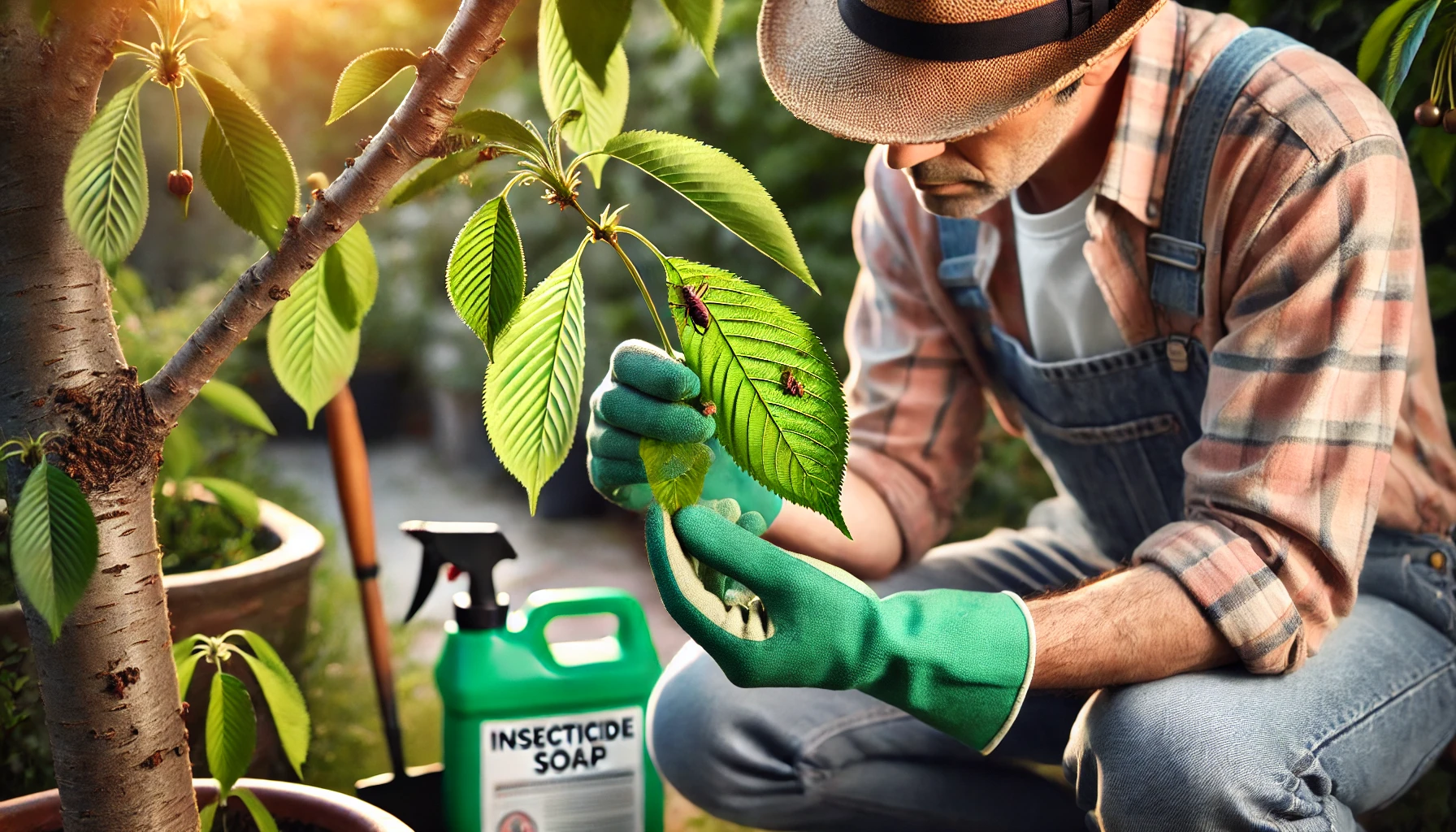
7. Watering Techniques 
Water your cherry tree early in the morning to avoid creating a damp environment that attracts fungal growth. Deep watering is best to encourage strong root development.
By staying proactive and consistent, you can keep your cherry tree healthy and thriving year after year!
Winter Care and Overwintering Tips 

As the colder months approach, taking the right steps to protect your plants is essential for their survival and healthy growth in the spring. Here are some winter care tips to keep your plants thriving:
1. Bring Potted Plants Indoors 
If you have plants in containers, move them inside to protect them from freezing temperatures. Place them in a cool, sunny spot to ensure they get enough light.
2. Mulch Around Plants 

For outdoor plants, apply a thick layer of mulch around the base. This helps to insulate the roots from frost and retain moisture during the winter months.
3. Water Carefully 
Plants still need some water during the winter, but be careful not to overwater. Water deeply but infrequently, ensuring the soil has time to dry out between watering sessions.
4. Protect Against Frost 
Cover sensitive plants with frost cloths or burlap to protect them from freezing temperatures. Be sure to remove the coverings during sunny days to avoid overheating.

5. Prune Dead or Damaged Growth 
Trim back any dead or damaged branches before winter sets in. This prevents the spread of disease and promotes healthy growth when the weather warms up.
6. Monitor Indoor Conditions 
Indoor plants benefit from consistent temperature and humidity levels. Keep them away from drafty windows and heating vents to prevent stress.
By following these easy winter care tips, you’ll ensure that your plants stay healthy and ready for the next growing season!
Troubleshooting Common Issues 

Even the healthiest plants can face issues. Here are common problems you might encounter and how to fix them:
1. Yellowing Leaves 
- Cause: Overwatering or poor drainage.
- Solution: Ensure your plant has well-drained soil. Allow the soil to dry out before watering again.

2. Brown Leaf Tips 
- Cause: Underwatering or dry air.
- Solution: Keep the humidity level up and water regularly, especially during dry spells.
3. Wilting Despite Watering 
- Cause: Root rot due to overwatering.
- Solution: Check the roots. If they’re mushy, trim them and repot in fresh, well-draining soil.
4. Pests 
- Cause: Aphids, mealybugs, or spider mites.
- Solution: Spray with insecticidal soap or neem oil. Wipe leaves with a damp cloth to remove pests.
5. Stunted Growth 
- Cause: Lack of nutrients or improper light.
- Solution: Fertilize your plant with a balanced, slow-release fertilizer and ensure it gets enough light.
6. Leaves Curling 
- Cause: Environmental stress, like temperature fluctuations or pests.
- Solution: Keep your plant in a consistent, mild environment and check for pests.
By understanding these common issues, you can ensure your plant stays healthy and thrives. Happy gardening!
Conclusion 

Caring for cherry trees in containers offers a unique opportunity to enjoy fresh, homegrown fruit, even in small spaces. By following the tips and practices shared in this guide—choosing the right variety, selecting the perfect container, ensuring proper watering and sunlight, and managing pests and diseases—you can foster healthy, thriving cherry trees that will reward you with beautiful blossoms and delicious fruit year after year.

Remember, patience and consistency are key to success. With the right care and attention, your container-grown cherry tree can flourish, becoming a focal point in your garden or balcony. So, whether you’re a seasoned gardener or just starting out, don’t hesitate to take the first step in growing your very own cherry tree. Happy gardening!
Frequently Asked Questions(FAQ)
What type of cherry tree is best for containers?
For container growth, dwarf and semi-dwarf cherry tree varieties are the best choice. These trees stay compact and manage their size well, making them perfect for confined spaces like balconies, patios, or small gardens.
How big should the container be for a cherry tree?
Choose a container that’s at least 18–24 inches in diameter and 18–24 inches deep. This gives the tree enough space for its roots to grow and ensures good drainage to prevent waterlogging.
How often should I water my cherry tree in a container?
Cherry trees in containers need regular watering, especially during warm weather. Water deeply when the soil feels dry 1-2 inches below the surface. Be careful not to overwater, as this can lead to root rot.
Do cherry trees in containers need fertilizer?
Yes, container-grown cherry trees need fertilizing to support their growth. Use a balanced, slow-release fertilizer in early spring when new growth begins and reapply during the growing season. Organic fertilizers are often a good choice for healthier, eco-friendly growth.
Can cherry trees in containers produce fruit?
Yes, cherry trees in containers can produce fruit, especially if they’re a self-pollinating variety. If not, ensure you have more than one tree for cross-pollination. Regular pruning and care will help maximize fruit production.
How do I prune my cherry tree in a container?
Prune your cherry tree to maintain its shape and remove dead or damaged wood. Aim to prune after the fruiting season, removing any weak growth while allowing sunlight to reach the center of the tree. This promotes better airflow and helps the tree thrive.
Can cherry trees in containers survive winter?
Yes, but cherry trees in containers are more vulnerable to freezing temperatures. To protect them, move the pot to a sheltered area or insulate the container with burlap, straw, or other materials. Alternatively, you can bring smaller pots indoors during the winter.
What are common problems with cherry trees in containers?
Common issues include yellowing leaves (usually due to overwatering or nutrient deficiencies), root-bound trees (which need repotting), and pest infestations. Regular monitoring and timely care can help prevent and solve most problems.












